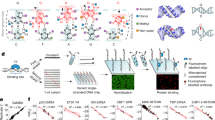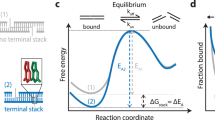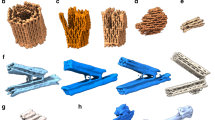Abstract
The recognition of specific DNA sequences by proteins is thought to depend on two types of mechanism: one that involves the formation of hydrogen bonds with specific bases, primarily in the major groove, and one involving sequence-dependent deformations of the DNA helix. By comprehensively analysing the three-dimensional structures of protein–DNA complexes, here we show that the binding of arginine residues to narrow minor grooves is a widely used mode for protein–DNA recognition. This readout mechanism exploits the phenomenon that narrow minor grooves strongly enhance the negative electrostatic potential of the DNA. The nucleosome core particle offers a prominent example of this effect. Minor-groove narrowing is often associated with the presence of A-tracts, AT-rich sequences that exclude the flexible TpA step. These findings indicate that the ability to detect local variations in DNA shape and electrostatic potential is a general mechanism that enables proteins to use information in the minor groove, which otherwise offers few opportunities for the formation of base-specific hydrogen bonds, to achieve DNA-binding specificity.
This is a preview of subscription content, access via your institution
Access options
Subscribe to this journal
Receive 51 print issues and online access
$199.00 per year
only $3.90 per issue
Buy this article
- Purchase on Springer Link
- Instant access to full article PDF
Prices may be subject to local taxes which are calculated during checkout





Similar content being viewed by others
References
Garvie, C. W. & Wolberger, C. Recognition of specific DNA sequences. Mol. Cell 8, 937–946 (2001)
Seeman, N. C., Rosenberg, J. M. & Rich, A. Sequence-specific recognition of double helical nucleic acids by proteins. Proc. Natl Acad. Sci. USA 73, 804–808 (1976)
Travers, A. A. DNA conformation and protein binding. Annu. Rev. Biochem. 58, 427–452 (1989)
Shakked, Z. et al. Determinants of repressor/operator recognition from the structure of the trp operator binding site. Nature 368, 469–473 (1994)
Lu, X. J., Shakked, Z. & Olson, W. K. A-form conformational motifs in ligand-bound DNA structures. J. Mol. Biol. 300, 819–840 (2000)
Hegde, R. S., Grossman, S. R., Laimins, L. A. & Sigler, P. B. Crystal structure at 1.7 Å of the bovine papillomavirus-1 E2 DNA-binding domain bound to its DNA target. Nature 359, 505–512 (1992)
Kim, Y., Geiger, J. H., Hahn, S. & Sigler, P. B. Crystal structure of a yeast TBP/TATA-box complex. Nature 365, 512–520 (1993)
Kim, J. L., Nikolov, D. B. & Burley, S. K. Co-crystal structure of TBP recognizing the minor groove of a TATA element. Nature 365, 520–527 (1993)
Otwinowski, Z. et al. Crystal structure of trp repressor/operator complex at atomic resolution. Nature 335, 321–329 (1988)
Hizver, J., Rozenberg, H., Frolow, F., Rabinovich, D. & Shakked, Z. DNA bending by an adenine–thymine tract and its role in gene regulation. Proc. Natl Acad. Sci. USA 98, 8490–8495 (2001)
Rohs, R., Sklenar, H. & Shakked, Z. Structural and energetic origins of sequence-specific DNA bending: Monte Carlo simulations of papillomavirus E2-DNA binding sites. Structure 13, 1499–1509 (2005)
Joshi, R. et al. Functional specificity of a Hox protein mediated by the recognition of minor groove structure. Cell 131, 530–543 (2007)
Burkhoff, A. M. & Tullius, T. D. Structural details of an adenine tract that does not cause DNA to bend. Nature 331, 455–457 (1988)
Haran, T. E. & Mohanty, U. The unique structure of A-tracts and intrinsic DNA bending. Q. Rev. Biophys. 42, 41–81 (2009)
Crothers, D. M. & Shakked, Z. in Oxford Handbook of Nucleic Acid Structures (ed. Neidle, S.) 455–470 (Oxford Univ. Press, 1999)
Passner, J. M., Ryoo, H. D., Shen, L., Mann, R. S. & Aggarwal, A. K. Structure of a DNA-bound Ultrabithorax–Extradenticle homeodomain complex. Nature 397, 714–719 (1999)
Li, T., Jin, Y., Vershon, A. K. & Wolberger, C. Crystal structure of the MATa1/MATα2 homeodomain heterodimer in complex with DNA containing an A-tract. Nucleic Acids Res. 26, 5707–5718 (1998)
Reményi, A. et al. Differential dimer activities of the transcription factor Oct-1 by DNA-induced interface swapping. Mol. Cell 8, 569–580 (2001)
Shen, A., Higgins, D. E. & Panne, D. Recognition of AT-Rich DNA binding sites by the MogR repressor. Structure 17, 769–777 (2009)
Stefl, R., Wu, H., Ravindranathan, S., Sklenar, V. & Feigon, J. DNA A-tract bending in three dimensions: solving the dA4T4 vs. dT4A4 conundrum. Proc. Natl Acad. Sci. USA 101, 1177–1182 (2004)
Tolstorukov, M. Y., Colasanti, A. V., McCandlish, D. M., Olson, W. K. & Zhurkin, V. B. A novel roll-and-slide mechanism of DNA folding in chromatin: implications for nucleosome positioning. J. Mol. Biol. 371, 725–738 (2007)
Watkins, S., van Pouderoyen, G. & Sixma, T. K. Structural analysis of the bipartite DNA-binding domain of Tc3 transposase bound to transposon DNA. Nucleic Acids Res. 32, 4306–4312 (2004)
Aggarwal, A. K., Rodgers, D. W., Drottar, M., Ptashne, M. & Harrison, S. C. Recognition of a DNA operator by the repressor of phage 434: a view at high resolution. Science 242, 899–907 (1988)
Davey, C. A., Sargent, D. F., Luger, K., Maeder, A. W. & Richmond, T. J. Solvent mediated interactions in the structure of the nucleosome core particle at 1.9 Å resolution. J. Mol. Biol. 319, 1097–1113 (2002)
Trifonov, E. N. & Sussman, J. L. The pitch of chromatin DNA is reflected in its nucleotide sequence. Proc. Natl Acad. Sci. USA 77, 3816–3820 (1980)
Segal, E. et al. A genomic code for nucleosome positioning. Nature 442, 772–778 (2006)
Satchwell, S. C., Drew, H. R. & Travers, A. A. Sequence periodicities in chicken nucleosome core DNA. J. Mol. Biol. 191, 659–675 (1986)
Travers, A. A. & Klug, A. in DNA Topology and its Biological Effects (eds Cozzarelli, N. R. & Wang, J. C.) 57–106 (Cold Spring Harbor Press, 1990)
Field, Y. et al. Distinct modes of regulation by chromatin encoded through nucleosome positioning signals. PLOS Comput. Biol. 4, e1000216 (2008)
Segal, E. & Widom, J. Poly(dA:dT) tracts: major determinants of nucleosome organization. Curr. Opin. Struct. Biol. 19, 65–71 (2009)
Honig, B. & Nicholls, A. Classical electrostatics in biology and chemistry. Science 268, 1144–1149 (1995)
Jayaram, B., Sharp, K. A. & Honig, B. The electrostatic potential of B-DNA. Biopolymers 28, 975–993 (1989)
Tsai, C. J., Lin, S. L., Wolfson, H. J. & Nussinov, R. Studies of protein-protein interfaces: a statistical analysis of the hydrophobic effect. Protein Sci. 6, 53–64 (1997)
Nadassy, K., Wodak, S. J. & Janin, J. Structural features of protein-nucleic acid recognition sites. Biochemistry 38, 1999–2017 (1999)
Luscombe, N. M., Laskowski, R. A. & Thornton, J. M. Amino acid-base interactions: a three-dimensional analysis of protein-DNA interactions at an atomic level. Nucleic Acids Res. 29, 2860–2874 (2001)
Kissinger, C. R., Liu, B. S., Martin-Blanco, E., Kornberg, T. B. & Pabo, C. O. Crystal structure of an engrailed homeodomain-DNA complex at 2.8 Å resolution: a framework for understanding homeodomain-DNA interactions. Cell 63, 579–590 (1990)
Meinke, G. & Sigler, P. B. DNA-binding mechanism of the monomeric orphan nuclear receptor NGFI-B. Nature Struct. Biol. 6, 471–477 (1999)
Gearhart, M. D., Holmbeck, S. M., Evans, R. M., Dyson, H. J. & Wright, P. E. Monomeric complex of human orphan estrogen related receptor-2 with DNA: a pseudo-dimer interface mediates extended half-site recognition. J. Mol. Biol. 327, 819–832 (2003)
Rohs, R., West, S. M., Liu, P. & Honig, B. Nuance in the double-helix and its role in protein-DNA recognition. Curr. Opin. Struct. Biol. 19, 171–177 (2009)
Richmond, T. J. & Davey, C. A. The structure of DNA in the nucleosome core. Nature 423, 145–150 (2003)
Locasale, J. W., Napoli, A. A., Chen, S., Berman, H. M. & Lawson, C. L. Signatures of protein-DNA recognition in free DNA binding sites. J. Mol. Biol. 386, 1054–1065 (2009)
Tolstorukov, M. Y., Virnik, K. M., Adhya, S. & Zhurkin, V. B. A-tract clusters may facilitate DNA packaging in bacterial nucleoid. Nucleic Acids Res. 33, 3907–3918 (2005)
Parker, S. C., Hansen, L., Abaan, H. O., Tullius, T. D. & Margulies, E. H. Local DNA topography correlates with functional noncoding regions of the human genome. Science 324, 389–392 (2009)
Lavery, R. & Sklenar, H. Defining the structure of irregular nucleic acids: conventions and principles. J. Biomol. Struct. Dyn. 6, 655–667 (1989)
Rocchia, W. et al. Rapid grid-based construction of the molecular surface and the use of induced surface charge to calculate reaction field energies: applications to the molecular systems and geometric objects. J. Comput. Chem. 23, 128–137 (2002)
Murzin, A. G., Brenner, S. E., Hubbard, T. & Chothia, C. SCOP: a structural classification of proteins database for the investigation of sequences and structures. J. Mol. Biol. 247, 536–540 (1995)
Petrey, D. & Honig, B. GRASP2: visualization, surface properties, and electrostatics of macromolecular structures and sequences. Methods Enzymol. 374, 492–509 (2003)
McDonald, I. K. & Thornton, J. M. Satisfying hydrogen bonding potential in proteins. J. Mol. Biol. 238, 777–793 (1994)
Brenner, S. E., Koehl, P. & Levitt, M. The ASTRAL compendium for protein structure and sequence analysis. Nucleic Acids Res. 28, 254–256 (2000)
Cornell, W. D. et al. A 2nd generation force-field for the simulation of proteins, nucleic-acids, and organic-molecules. J. Am. Chem. Soc. 117, 5179–5197 (1995)
Acknowledgements
This work was supported by National Institutes of Health (NIH) grants GM54510 (R.S.M.) and U54 CA121852 (B.H. and R.S.M.). The authors thank A. Califano for many helpful conversations.
Author Contributions R.R., A.S., R.S.M. and B.H. contributed to the original conception of the project; S.M.W. and R.R. generated and analysed the data assisted by P.L.; and R.R., S.M.W., R.S.M. and B.H. wrote the manuscript.
Author information
Authors and Affiliations
Corresponding authors
Supplementary information
Supplementary information
This file contains Supplementary Tables 1- 4, Supplementary Figures 1-6 with Legends and Supplementary References. (PDF 2746 kb)
Rights and permissions
About this article
Cite this article
Rohs, R., West, S., Sosinsky, A. et al. The role of DNA shape in protein–DNA recognition. Nature 461, 1248–1253 (2009). https://doi.org/10.1038/nature08473
Received:
Accepted:
Issue Date:
DOI: https://doi.org/10.1038/nature08473
This article is cited by
-
Three new LmbU targets outside lmb cluster inhibit lincomycin biosynthesis in Streptomyces lincolnensis
Microbial Cell Factories (2024)
-
Predicting DNA structure using a deep learning method
Nature Communications (2024)
-
Polymorphisms within DIO2 and GADD45A genes increase the risk of liver disease progression in chronic hepatitis b carriers
Scientific Reports (2023)
-
Energy-driven genome regulation by ATP-dependent chromatin remodellers
Nature Reviews Molecular Cell Biology (2023)
-
Experimental detection of conformational transitions between forms of DNA: problems and prospects
Biophysical Reviews (2023)
Comments
By submitting a comment you agree to abide by our Terms and Community Guidelines. If you find something abusive or that does not comply with our terms or guidelines please flag it as inappropriate.



